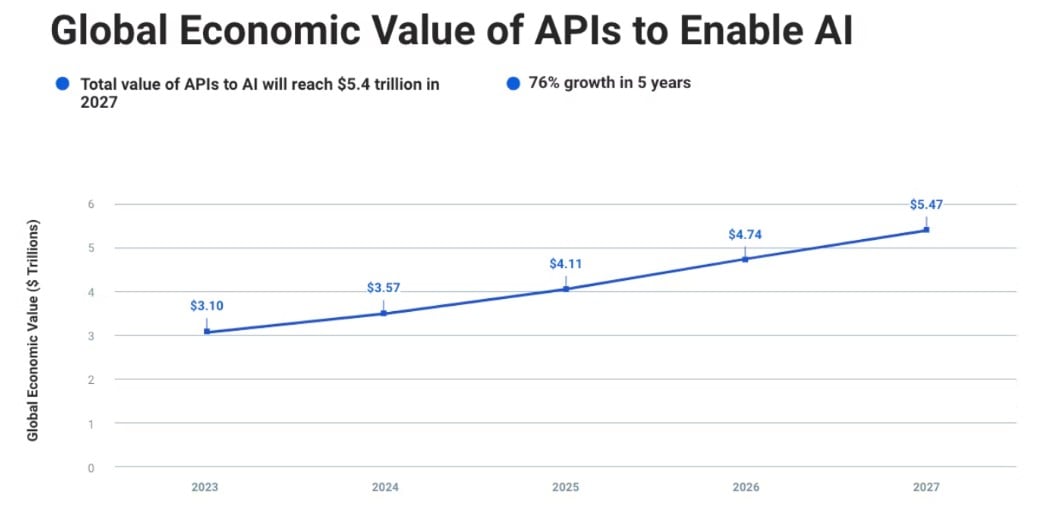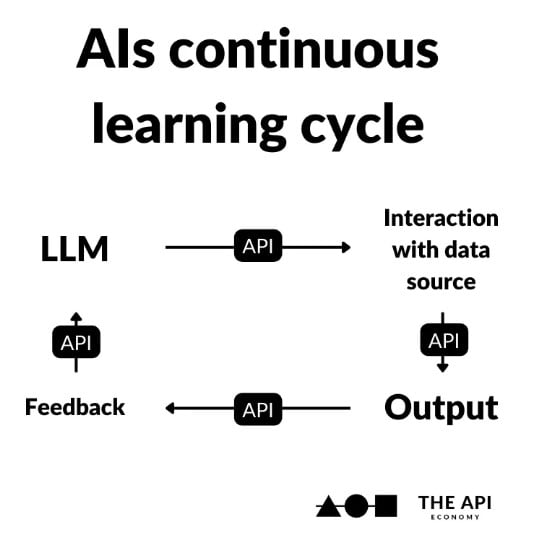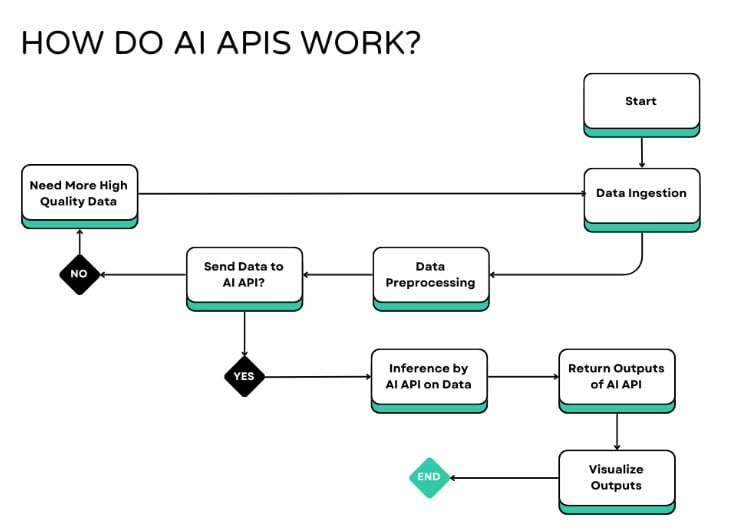Introduction
Businesses are constantly on the lookout for new and exciting ways to serve their customers. Artificial intelligence (AI) APIs (Application Programming Interfaces) are powerful tools that can drive innovation in a business. AI APIs allow developers to add intelligent features to their apps without developing AI modules from scratch. For example, they can teach apps to understand and respond to human language (NLP or Natural Language Processing), recognise pictures, and even figure out one’s emotions. AI capabilities make applications more helpful and user-friendly for everyone.

Many industries, such as healthcare, finance, and customer service, are already benefiting from AI APIs. The AI API market is growing fast, with its value expected to jump from $3.1 trillion in 2023 to $5.4 trillion in 2027. The AI API market projection shows just how important AI solutions are becoming. With AI APIs, businesses can innovate and improve their services, boosting efficiency and improving user experiences. In this article, we will take a closer look at AI APIs and how they are transforming our lives.
Understanding AI APIs
An AI API is a set of tools that allow developers to add artificial intelligence features to their apps without building them from scratch. These features, like NLP, make it easy for anyone to use advanced AI in their projects, even without deep AI knowledge. Most big tech companies offer these APIs, making AI technology more accessible and efficient for developers. These APIs come in two forms: AI-based API and AI-enabled API.
An AI-based API offers direct access to artificial intelligence services. It is like a pre-built AI assistant that can be added to apps to perform tasks like language processing or computer vision techniques. These APIs make it easy to add advanced AI capabilities by handling the complicated parts of training and deploying AI models. Developers can quickly integrate these features, improving app functionality and user experience.
On the other hand, an AI-enabled API gives a regular tool intelligence. Basically, they are traditional APIs improved with AI and machine learning. AI features are used to improve their overall performance and user experience. For example, an AI-enabled search API might use AI to give you better search results. Both types of APIs simplify the integration of AI, making it accessible and beneficial for many applications.

How Do AI APIs Work?
Now that we understand what AI APIs are, let’s explore how they work. Most core AI APIs receive data that has been preprocessed so that the data is clean, relevant, and in a suitable format for analysis. Preprocessing removes noise and errors, converts data into a consistent format, and helps identify important features.
Once the data is ready, the AI API’s main purpose is to apply various algorithms and models to analyse it. Regardless of the type of analysis, there are a few common options. Either the model will be hosted on cloud infrastructure or deployed locally. This depends on the application’s requirements and the volume of data.
If the model is hosted on the cloud, the data is sent to a remote server where the AI model processes it. The cloud approach is scalable and can handle large datasets efficiently. Cloud-based models, like those offered by Google Cloud AI, AWS AI Services, and Microsoft Azure AI, let you add complex analyses to your application without requiring significant local resources.

On the other hand, some applications might deploy models locally on edge devices or on-premises servers. The edge approach is beneficial for real-time processing and when dealing with sensitive data that must remain within a secure environment. Local deployment can reduce latency and dependency on internet connectivity. It is suitable for use cases like autonomous vehicles, industrial automation, and healthcare devices.
After the model processes the data, it generates insights and outputs. These outputs can take various forms, like generated text, images, forecasted trends, and personalised suggestions. An AI API will typically return this output to your application, where another module will work on transforming these insights into a usable format like visualisations such as graphs and charts or triggering automated actions that integrate with other workflows and systems.
Specific AI API Use Cases
Now that we have a better understanding of AI APIs and the many benefits they bring, let’s explore some of their use cases.
Image Recognition APIs

Image recognition technology allows machines to see and understand visual data. It is used in many applications, such as facial recognition or detecting objects and landmarks in images and video files. Given the massive volume of images processed daily for applications like security systems and industrial production systems, image recognition technology is essential for enhancing efficiency and productivity. Tasks such as identifying similar images or recognising landmarks would be nearly impossible without these advanced APIs.
Several major tech companies offer powerful image recognition APIs. Google’s Cloud Vision API is a great option for detailed image analysis, including text extraction (OCR - Optical Character Recognition) and object identification. Amazon Rekognition API focuses on practical applications and offers strong video analysis features and efficient image processing. OpenAI Vision stands out for its ability to provide descriptive answers about image content, while Microsoft Azure AI Vision offers a comprehensive toolset, including image and video analysis, along with options for custom model training. Each platform offers unique strengths and caters to different development needs.
Natural Language Processing (NLP) APIs

Natural Language Processing (NLP) is an AI technique that helps computers understand and use human language. NLP tools can read text, determine its meaning, gauge the writer’s sentiment, and identify the intended message. It is useful for extracting and understanding large amounts of information from natural language. Similar to image processing, there are APIs for NLP. Many companies offer these NLP APIs to help businesses leverage language data effectively.
Here are some examples:
-
IBM: IBM Watson NLP specialises in detailed text analysis, understanding sentence structure, and extracting key information.
-
Amazon: Amazon Comprehend efficiently processes large volumes of text, extracting insights while prioritising data privacy.
-
Google: Google Assistant API focuses on conversational interactions, offering speech-to-text, text-to-speech, and natural language understanding capabilities.
Machine Learning Model APIs
Machine learning models are computer programs that are trained on data to recognise patterns and make predictions. These models are the core components that power many innovative applications across industries, from finance and healthcare to retail and transportation. By using APIs, developers can integrate powerful machine learning models into their apps without needing to know all the technical details behind how the models work.
There are many frameworks used to deploy these machine learning models as APIs, like TensorFlow Serving, AWS SageMaker, and Azure Machine Learning. We’ll dive deep into them in the next section.
Frameworks and Tools
Creating, training, and deploying machine learning models is much simpler with the help of popular frameworks and tools. Here’s a look at some of the most commonly used ones:
TensorFlow Serving
TensorFlow Serving is an open-source system developed by Google for deploying machine learning models. It simplifies the integration of TensorFlow models into real-world applications by providing access through HTTP REST API or gRPC. It allows your applications to make model-generated predictions (such as classifications, forecasts, or recommendations) by sending requests to the API. Some of its key features include model versioning for easy updates, automatic batching of requests for efficient responses, and support for canary deployments to test new models without affecting the main application.
Amazon SageMaker
Amazon SageMaker is a fully managed service from AWS that simplifies the process of building, training, and deploying machine learning models. It offers a comprehensive set of tools, including notebooks, debuggers, profilers, and MLOps (Machine Learning Operations) features. It also offers an endpoint to deploy your trained models as APIs. You can use the endpoints to get predictions from your models by making API calls. SageMaker handles infrastructure management and scaling, supports repeatable ML(Machine Learning) workflows with governance features, and provides access to many pre-trained models that can be deployed quickly.
Read more: Introduction to MLOps
Azure Machine Learning
Azure Machine Learning is a cloud platform from Microsoft designed to accelerate and automate machine learning workflows. It supports models created with popular Python frameworks like PyTorch, TensorFlow, and Scikit-learn. It also provides endpoints for deploying models as web services, which can be accessed via REST APIs. It allows your applications to interact with your machine-learning models through API requests. Key features include automated featurisation and algorithm selection, hyperparameter optimisation, and multimode-distributed training for efficient model training.
Hugging Face Transformers
Hugging Face Transformers is a well-known open-source library for NLP models that offers access to a vast range of pre-trained language models. With over 25,000 models available, it supports tasks like text generation, question answering, and text classification. The library makes it easy to load and use these models with minimal code and provides tools for sharing and versioning models on the Hugging Face Hub. While it does not directly offer API deployment, you can deploy models using the Hugging Face Inference API, set up custom deployments on your own infrastructure or cloud services, or integrate with cloud platforms like AWS SageMaker and Azure Machine Learning to expose models as APIs.
Technical Integration
Integrating AI APIs into your applications requires several steps, and careful planning can guarantee a smooth and successful process. Here are seven steps to help you navigate the integration.

-
Step 1: Start by defining the features you want to add to your app.
-
Step 2: Then, you can select APIs that are compatible with your app’s programming language and framework and are reliable, secure, scalable, and performant.
-
Step 3: After you have selected APIs. You can gather and prepare high-quality data for training the AI models. Keep in mind that outdated or poorly formatted data can affect machine learning deployment.
-
Step 4: The next step is to train and test your AI models until they perform well.
-
Step 5: After training and testing your model, integrate the trained model into your app’s architecture and user interface. Design and implement software components that interact with the model, such as data input and output, preprocessing, and postprocessing.
-
Step 6: Thoroughly test the integration to make sure it works as expected and that there are no compatibility issues with your existing code.
-
Step 7: Then, you can monitor and improve the AI models’ performance over time.
Best Practices & Challenges in AI API Integration
When executing the steps involved in AI API integration, it is also important to follow best practices. For example, it is essential to review all API documentation thoroughly to understand how to make calls, handle responses, and manage errors. A few points to focus on are authentication methods, example requests, and rate limits. After reading the documentation, it is key to ensure compliance with data protection regulations like GDPR and CCPA. You can use HTTPS, secure API keys, and implement rate limiting. Regular audits can identify and address security vulnerabilities.
You can improve efficiency by batching requests, implementing caching, and using asynchronous processing. Monitor API usage to stay within rate limits and plan for handling scenarios where limits are reached. Be sure to design your application to handle errors like authentication issues. Implement user-friendly error messages, logging, alerts, and retry logic to maintain stability.
Even when following best practices, integrating AI into your applications can come with its own set of challenges. For instance, developing AI applications often relies on external services like GPT models. The over-reliance on such third-party services can be a major challenge because if they encounter issues, it can disrupt your AI application.
Having backup options is vital to prevent such interruptions. Crafting effective prompts, or “prompt engineering,” is also crucial for getting desired results from AI. Developers need a deep understanding of how the AI model works to perfect prompts. Aside from this, there are challenges related to data and resources. High-quality data is the backbone of any successful AI project. Poor data can impact performance in a negative manner. Obtaining and cleaning good-quality data can be time-consuming and expensive. Handling these challenges requires the expertise of a solution provider like TechnoLynx.
What We Can Offer as TechnoLynx
At TechnoLynx, we specialise in creating custom software tailored to your unique needs. Our expertise in custom software engineering can help make your business processes more streamlined and efficient. Whether you need advanced AI solutions or bespoke software, our team is ready to deliver outstanding results.
We have skills in various cutting-edge technologies, including edge computing, IoT (Internet of Things), computer vision, generative AI, GPU (Graphics Processing Unit) acceleration, natural language processing, and AR/VR/XR (Augmented Reality/Virtual Reality/Extended Reality). These capabilities allow us to help you explore new possibilities and enhance your business operations. As your AI consultant, we can guide you through every step of integrating AI into your workflows.
If you’re ready to take your business to the next level with innovative AI and custom software solutions, contact TechnoLynx today. Let’s innovate and build the future together!
Conclusion
With ongoing advancements in machine learning and natural language processing, it is likely that AI APIs will become increasingly common in applications across different industries. These innovations will make sectors, from healthcare to finance, more efficient and capable. AI APIs have the power to transform industries by boosting productivity, automating complex tasks, and offering deeper insights through data analysis.
As these technologies continue to evolve, their impact on businesses and daily life will be significant. If you’re interested in harnessing the power of AI APIs for your projects, reach out to TechnoLynx. Our team of experts can help you integrate the latest AI solutions to stay ahead in the fast-changing tech world.
Sources for the images
-
CSolitair. (n.d.) ‘Natural Language Processing’, Github.
-
Hassanin, N. (2023) ‘Law professor explores racial bias implications in facial recognition technology’, University of Calgary.
-
Nikolaieva, A. (2024) ‘How to Integrate AI Into Your App: 7 Steps Guide’, Uptech.
-
Pulsifer, E. (2023) ‘The Economic Impact of APIs: API Monetization, AI, Web3, and Beyond’, Kong.
-
Schroeder, P. (2023) ‘AI & APIs’, Apifirst.
References
-
Darbinyan, R., 2022. What Are AI APIs, and How Do They Work?. [online] Dataversity.
-
Pulsifer, E., 2023. The Economic Impact of APIs: API Monetization, AI, Web3, and Beyond. [online] KongHQ.
-
Simpson, J., 2020. 7 Best Image Recognition APIs. [online] Nordic APIs.
-
Srivastava, V., 2022. 10 Natural Language Processing (NLP) APIs. [online] Nordic APIs.
-
Uptech, 2024. How to Integrate AI into Your App: Comprehensive Guide. [online].












